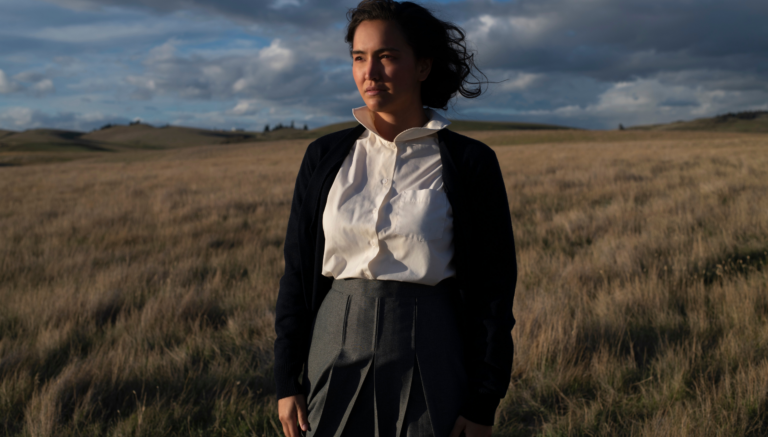By Deena Goodrunning, Local Journalism Initiative Reporter
(ANNews) – Bones of Crows is a film that premiered at the Toronto International Film festival on September 10, 2022. It also screened at the 2022 Edmonton International Film Festival and the 2022 Calgary International Film Festival. The film, directed and written by Marie Clements, tells the story of a Cree matriarch named Aline Spears (Grace Dove).
The film follows Aline from her early days of childhood freedom living with her family on the Canadian prairies, to her prison-like days in residential school, to her time spent serving as a Cree codetalker during World War 2 and then finally to the day of confrontation with the Catholic Church.
Since the story of the film begins in the 1800s and ends in the 2000s, there are multiple important characters that we meet. A couple of the notable main characters include Aline’s younger sister Perseverance (Alyssa Wapanatâhk) and Aline’s husband Adam Whallach (Phillip Lewitski.)
The story is told in a nonlinear fashion, with flashbacks and time jumps often interspersed into the film. The effect is jarring and intense, making one feel as if they are in the film experiencing the disorientation and agitation that the characters feel as they recall memories of the past.
The cinematography is also very sharp and poetic and masterful. While I sat in the theatre watching the screen, there were times that I felt entranced by the film, almost as if I was experiencing a dream or a terrible nightmare. I write ‘terrible nightmare,’ because the film deals with very disturbing and dark topics and situations. There are scenes of racism, child abuse, rape, death, prostitution and war.
As a result, the film is incredibly distressing. There were multiple scenes being shown on screen were absolutely horrifying to watch and listen to. But, if some scenes are horrifying it’s because Bones of Crows is based on the true and horrific experiences that Indigenous people in Canada have gone through. In the film there’s no sugar coating or downplaying the truth of the terrible things that happened to Indigenous people in Canada’s history.
In an essay published on CBC as a part of their Cutaways series, the director Marie Clements wrote that: “Bones of Crows is a cinematic response to our lived history in Canada, where the reign of terror against Indigenous people included starvation, disease warfare, sterilization, residential schools and pedophilia, paving a highway for the Sixties Scoop, Murdered and Missing Indigenous Women and Girls, poverty, the incarceration of Indigenous people, environmental crisis and the foster care system. This story is committed to telling the hard truths and challenging a singular vision of history to create change.”
In my opinion, there are still a lot of people today in Canada who downplay the truths of residential schools and colonialism and how that negatively impacted Indigenous people and their culture. But, the truth of how colonialism in Canada has affected Indigenous people and culture must be told no matter how horrifying it is. It can’t be hidden away and downplayed.
And this film starkly shows the true horrors of colonialism in Canada. It shows the theft of Indigenous children by the government and it shows how Catholic priests and nuns abused Indigenous children. The film isn’t exaggerating the horror and cruelty, because the horrible things that happen in the film, happened in real life.
Additionally, the film touches on many other numerous horrible things that have and are happening to Indigenous people in Canada. Another truth the film shows is how Indigenous veterans were forced to give up their Indian status so that they could fight in World War 2, yet they were denied Veterans Benefits when returning home from the war. Additionally, the film shows how the Canadian government continues to apprehend Indigenous children even without the excuse of residential schools.
While the film does show multiple terrible truths, the film isn’t entirely tragic. There are also sweet and beautiful moments of kindness and love. What I find most beautiful about the film is how the film highlights the strength and resilience of Indigenous people and their culture.
The British Empire was one of the most powerful political organizations in the world. They colonized many parts of the world that included Africa, Asia, Australia and the Americas. At the time when residential schools were first established, Canada was still considered a dominion of the British Empire and maintained an allegiance to the British Crown. And the Catholic Church has been one of the most powerful and wealthiest religious organizations in the world for hundreds of years. Both Canada and the Catholic Church worked together with the purpose of assimilating Indigenous peoples and destroying their culture.
But, Indigenous culture has survived. Despite the starvation and disease and oppression that our people suffered under the hands of two of the most powerful organizations in the world, we have still persevered. We are a people of perseverance. And we’re still going to keep persevering.
To conclude, Bones of Crows is an emotional film that confronts and shows the truths of how colonialism in Canada affected Indigenous people. At the same time the movie celebrates and spotlight the perseverance of Indigenous people and culture in Canada. Although some scenes are difficult and distressing to watch, this movie is overall incredible and beautiful.
Bones of Crows is also expected to be expanded into a mini-series for CBC.



Be the first to comment on "Film Review: ‘Bones of Crows’ – A dark movie that highlights the perseverance of Indigenous people"